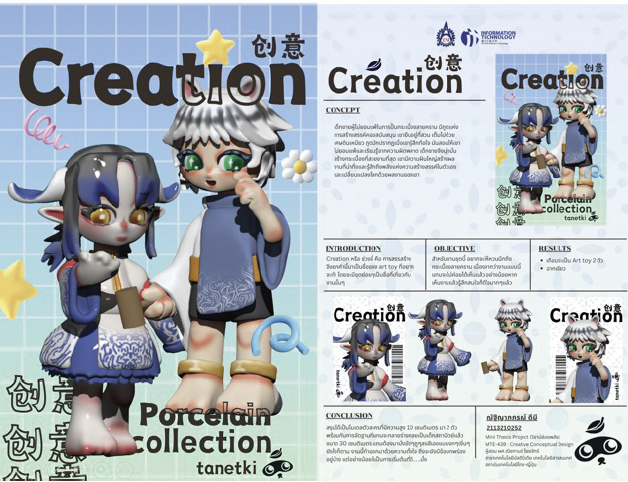Study of Teaching Approaches to Create Creative Works and Multimedia from Character Design Skills
DOI:
https://doi.org/10.69598/decorativeartsjournal.4.114-137Keywords:
creativity promotion activities, teaching management, character designAbstract
Currently, education must be designed to suit learners and promote students' creativity, leading to the creation of new innovations. Therefore, teaching should be tailored to meet learners' needs, developing them with essential future skills. This research is an experimental study aimed at exploring teaching theories and designing learning activities that foster creative character design, and summarizing the body of knowledge.
The research found that a combination of three instructional approaches is recommended: 1) Project-Based Learning, 2) Creative-Based Learning, and 3) Brain-Based Learning. Subsequently, learning activities were developed, divided into three main components: Activity 1 involved selecting topics to create projects, practicing analysis, exploration, and addressing personal and social needs, utilizing principles of effective collaboration, problem-solving, and inquiry. Activity 2 focused on developing ideas, evaluating approaches to extend characters into creative works and multimedia, and enhancing thinking skills. Activity 3 aimed to refine projects through personalized learning. Among the 38 participants, 19 (50%) chose topics related to character design, with the greatest interest in creating concept art, followed by animation, game design, corporate identity, art toys, and keycaps. Crucially, instructors must serve as mentors, providing individualized attention and fostering personal development based on each student's potential.
References
จรรยา เหตะโยธิน. (2564). แนวทางการออกแบบตัวละคร กรณีศึกษา ‘เดอะ คาแรคเตอร์ ดีไซน์ ชาเลนจ์. วารสารวิชาการคณะสถาปัตยกรรมศาสตร์ สจล., 32(1), 1–15. https://so04.tci-
thaijo.org/index.php/archkmitl/article/view/248380
ชวลิต ขอดศิริ และ วชิรา เครือคำอ้าย. (2567). การจัดการเรียนรู้แนวใหม่เพื่อเสริมสร้างทักษะแห่งโลกอนาคต.
วารสารปาริชาต, 37(2), 314-316. https://doi.org/10.55164/pactj.v37i2.268976
ณัฐวรรณ เฉลิมสุข, อนิรุทธ์ สติมั่น, ฐาปนีย์ ธรรมเมธา, และน้ำมนต์ เรืองฤทธิ์. (2566). การพัฒนารูปแบบการเรียนการสอน แบบผสมผสานวิชาศิลปศึกษาตามแนวทางการคิดเชิงออกแบบร่วมกับการเรียนศิลปะปฏิบัติที่บูรณาการเครื่องมือทางปัญญา เพื่อพัฒนาความคิดสร้างสรรค์ในการสร้างผลงานศิลปะของนักเรียนมัธยมศึกษาตอนปลาย.วารสาร ศึกษาศาสตร์ มหาวิทยาลัยนเรศวร, 25(3), 117-128.
ทวีศักดิ์ จินดานุรักษ์. (2559). การพัฒนาและประเมินความคิดสร้างสรรค์ในสถานศึกษา Creative Thinking Development and Evaluation in Schools. วารสารศึกษาศาสตร์, 27(1), 1-14.
ธารทิพย์ ขัวนา และ ขวัญชัย ขัวนา. (2561). การจัดการเรียนรู้เพื่อส่งเสริมความคิดสร้างสรรค์เชิงผลิตภาพทางการศึกษา : สู่ยุคการศึกษาไทยแลนด์ 4.0. วารสารสถาบันวิจัยและพัฒนา มหาวิทยาลัยราชภัฏมหาสารคาม, 5(2), 325-342.
ปัญจนาฏ วรวัฒนชัย. (2565). ความรู้พื้นฐานเกี่ยวกับความคิดสร้างสรรค์ Fundamental Knowledge in Creative Thinking. ครุศาสตร์สาร | Journal of Educational Studies, 16(1), 1-14.
วิชัย วงษ์ใหญ่ และ มารุต พัฒผล. (2563). การเรียนรู้เชิงสร้างสรรค์ (Creative Learning). จรัลสนิทวงศ์การพิมพ์.
สถาบันเทคโนโลยีไทย-ญี่ปุ่น. (2566). เทคโนโลยีมัลติมิเดีย. https://www.tni.ac.th/it/major_mt
สมพร สุธี. (2567). การวิจัยทางศิลปะ : กระบวนการสังเคราะห์สู่นวัตกรรม. คณะศิลปกรรมศาสตร์ มหาวิทยาลัยเทคโนโลยีราชมงคลธัญบุรี.
Seegmiller, D. (2008). Digital character painting using Photoshop CS3 (2). Charles River Media.
The Organisation for Economic Co-operation and Development (OECD). (n.d.). Future of Education and Skills 2030/2040. Retrieved April 28, 2025, from https://www.oecd.org/en/about/projects/future-of-education-and-skills-2030.html

Downloads
Published
How to Cite
Issue
Section
Categories
License
Copyright (c) 2025 DEC Journal

This work is licensed under a Creative Commons Attribution-NonCommercial-NoDerivatives 4.0 International License.
Published by Academic Affairs Division, Faculty of Decorative Arts, Silpakorn University. The copyright of the article belongs to the article owner. Published articles represent the views of the authors. The editorial board does not necessarily agree with and is not responsible for the content of such articles.


